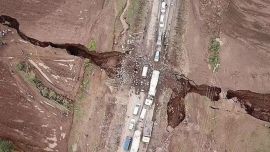Jorge Altieri runs his hands over old blood stains on a helmet that saved his life in 1982 when Argentina and Britain went to war over the Malvinas (Falkland) Islands.
Looking at the treasured object is still a novelty: the helmet was only recently returned to Altieri, decades after he lost it on the battlefield where he was almost killed by shrapnel.
“I have it next to me now and I use it like a teddy bear,” Altieri said. “I look at it and I get tearyeyed from all the memories.”
Argentina lost the war for the South Atlantic archipelago after its troops embarked on an ill-fated invasion nearly 37 years ago, an international humiliation that claimed the lives of 649 Argentines and 255 British soldiers.
After decades of tense relations, though, both countries have experienced a thaw, including a deal that allowed a multinational team of experts to exhume and identify the remains of dozens of Argentine soldiers.
Today, veterans and relatives of those who died also say the recovery of objects taken as war trophies has helped heal their scars.
“I can’t stop looking at it, thinking of what it did to stop the bomb shrapnel blowing my head off,” Altieri said about his helmet, although he still lost an eye and part of his brain in a blast during the battle for Mount Longdon on June 12, 1982, two days before fighting stopped.
In a parallel tale of reconciliation, Argentine veteran Diego Carlos Arreseigor announced March 7 that he is planning to return the blood-stained helmet of fallen British soldier Alexander Shaw, who was killed at Mount Longdon at age 25. The helmet is expected to be delivered to Shaw’s sister, Susan, in April or May.
“Susan touched me with her spirituality. She was 15 when her brother left for the war,” Arreseigor said.
Arreseigor said he had picked up the helmet in a pile of discarded equipment and hid it from a British soldier by keeping it under his jacket.
“I kept it these 37 years, always considering it a trophy of war, a sort of consolation for the loss and the pain of so many fallen friends,” he said.
Some years ago he became curious about who had worn it and noticed it had a last name written on one of its interior belts.
Arreseigor eventually found out Shaw’s identity and learned he had been a victim of Argentine artillery.
“The stor y moved me. Knowing that he died just hours before the ceasefire. ... it’s sad like all war stories,” he said. “I just turned 60 and I demand our sovereignty over Las Malvinas, but I also pay tribute to all of those who died — Argentine and British — because I think that’s the way to rebuild.”
For Altieri, having his helmet has helped him find similar closure.
After the war’s ceasefire, Altieri’s helmet was taken to London by a British paratrooper who had pulled it from a heap of military equipment. After the man passed away, it was kept by his family until it was put up for auction four years ago.
At the time, Altieri offered about US$520 (£400), but a British man who collects war objects paid twice that amount and Altieri failed to persuade him to sell it.
“He’d say: ‘Even if the Queen comes asking for it, I won’t give it away,’” Altieri recalled.
Some days ago, however, the helmet briefly went up for auction again on eBay for about US$13,000 (£10,500). When it was taken off the site, Altieri feared he had lost it for good until he heard the news: an anonymous Argentine entrepreneur had bought it for Altieri.
“All the memories of what I lived in the Malvinas came back to me,” Altieri said.
He now hopes to display it at
home before donating it to a museum about the war. “I want people to see it and see what happened to us there.”
related news
by BY ALMUNDENA CALATRAVA


















Comments